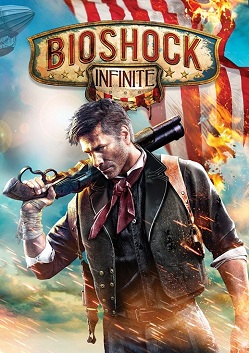 PUBLISHER: 2k Games
PUBLISHER: 2k GamesDEVELOPER: Irrational Games
Played on: PS3
Initial impression: Familiar but different.
Liked:
- Story
- New Gameplay Elements
- Featured Music
Disliked:
- Rail system
- Boss fight issue
On The Fence:
- Tone and Theme
Bring Us The Girl And Wipe
Away The Debt
It is 1912 America, and Columbia attempts to be a perfect,
pure example of all that is great - Pure, in every negative sense imaginable.
Bigotry, racial segregation, Nazism, jingoism, and xenophobia all play their
parts in the civil uprising that is taking place throughout the game. At times
it seems the setting is more Post-Civil
War Reconstruction Era than early 1910s.
All those rather
shocking (for some) aspects aside, the story is a good one. There is mystery
behind the main character’s motivation – like who sent him on this assignment? There is an extraordinary science fiction
element introduced by the main supporting character – a teenage girl with an
unusual power. A menacing overseer that literally swoops in and acts without
speaking. As the story unfolds, you are introduced to the history of Columbia –
both the sanitized, newsreel version and the gritty truth. There isn’t a whole
lot I can say about the plot without giving away major spoilers.
This incarnation of
Bioshock introduced a new spin on the old Plasmid system of powers, renamed
Vigors, by allowing a player to create traps with them. These newly styled
powers include things like a “Murder of Crows” – a stream of a dozen or so
crows to circle and harm the victim. That particular power, when used as a
trap, manifests as a nest, which explodes into birds when an enemy approaches.
 |
| Murder Of Crows in action |
While wandering
around Columbia, fans of mid-1980s to early 1990s music will no doubt catch a
familiar sounding tune coming across phonographs and loudspeakers. The
Irrational crew has done a great job reimagining some iconic pop songs as 1920s
era hits, and it’s all explained in-game how these came to be.
Dislikes
There’s a system of
rails that interconnects the various parts of the floating city. Think of it
like one of those suspended roller coasters. This skyhook system, for me, was
very difficult to navigate at times, especially when I had to rely on them to
hit the next plot point.
Boss Fights – well,
a specific boss fight at least – got on my nerves, especially since after I
defeated this character, I went to a new area and had to fight them again. What’s
the point in showing me this character’s defeat if they’re just going to pop up
again in 10-15 minutes? Thankfully there was only the one resurgence.
On The Fence
The Tone and Theme of this game is very dour. Comstock built Columbia as a refuge from all that was wrong in America, and apparently, to him, the non-white population was a huge part of what he felt was wrong. Between the museum exhibits demonizing the Chinese and the Native American and the segregation of the races, I felt the need to shake my head on several occasions based on what I saw and heard.
That said, I understand it. I’m
not saying I like it, but I’m not wholly offended. I’m not offended by
the racial bigotry, religious overtones, blatant preaching or apparent blasphemy that runs
all throughout the game, and neither should you. The game is a reflection of
the worst of the era. It’s no different than watching a film about slavery in
the early 1800s.
In Conclusion
In the end, the game
is a good follow up/prequel to the original Bioshock game story line. It is a
decent FPS with some minor RPG elements and a decent story that will have you
scratching your head by the end.
No comments:
Post a Comment